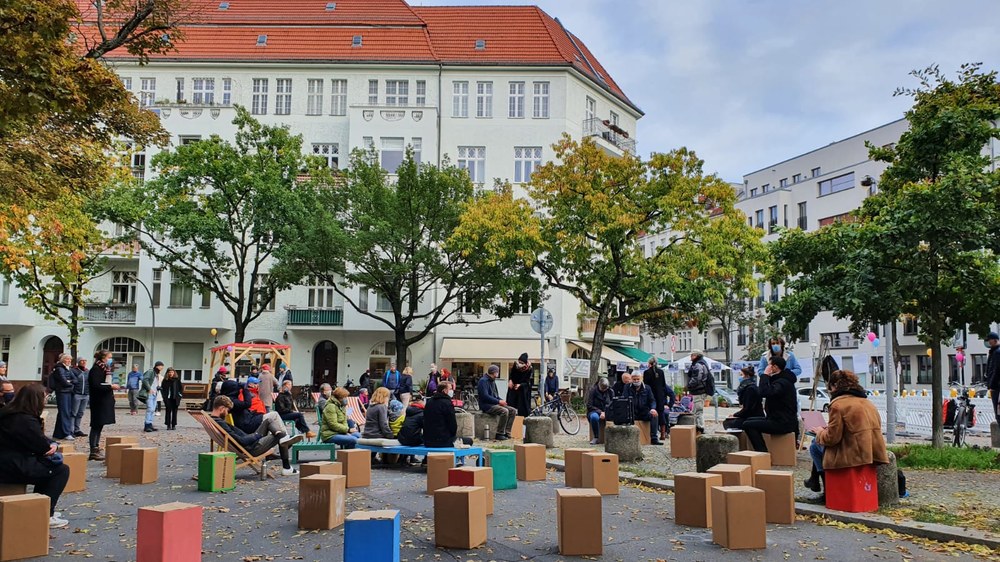EXPERI
The transport transition also raises the question of how urban spaces can be redesigned and utilised should cars take up less space in the future and alternative modes of transport dominate the streetscape. This offers the opportunity to develop more attractive, green and healthy neighbourhoods. This research project takes an experimental approach to investigate how the quality of the urban experience can be improved, how urban spaces for citizens can be created, and what steps can be taken to enable forms of mobility beneficial to human health. Three real-world experiments were conducted in Berlin featuring temporary interventions in the design of street areas and traffic routes. In addition, the project identifies how much land outside the streets is currently occupied by car infrastructure and the potential for other uses, such as housing.

Presentation of the EXPERI research project - Understanding the transport transition
Your consent to the storage of data ('cookies') is required for the playback of this video on Youtube.com. You can view and change your current data storage settings at any time under privacy.
EXPERI
Experimental spaces to rethink urban neighbourhoods
In autumn 2020, an intersection in Berlin Charlottenburg was transformed into a city square for five weeks and Lausitzer Platz in Kreuzberg began to be gradually converted into a pedestrian zone in winter 2020. A street in Schöneberg was made car-free in summer 2021 and transformed into a recreational space with parklets.
The community is encouraged to contribute and put their own ideas and design wishes into practice through participatory formats and joint design activities. The (temporary) transformation of the public space is then evaluated using a range of quantitative and qualitative methods, such as household surveys, (expert) interviews, traffic censuses, mapping or geographic information system analyses (GIS analyses).
Transfer through practical involvement
The project is supported by a scientific advisory board and partners from the field in order to ensure the development of real-life solution concepts. In addition, various stakeholders were involved and networked during the real-life experiments.

DLR / Uta Bauer
Leveraging the mobility transition in the experimental space
It is evident that the redesign of urban spaces is currently a controversial topic, with younger people being more open to change than their elders. People's daily mobility behaviour is particularly decisive for the acceptance of the redesign: Insofar as people frequently use cars for their journeys, they perceive their surroundings differently and are significantly more negative. At the same time, the use of bicycles promotes the public's acceptance of traffic calming measures. The results of the real-life experiments can show on a small scale which adjustments are important for the (city-wide) transport transition: The choice of transport mode is crucial for determining the need for traffic calming measures. As far as the specific design of the new urban spaces is concerned, there is a consensus that green areas and seating in public spaces are particularly desirable.
The results will be embedded in the context of international examples of pedestrian-friendly infrastructure (for example superblocks in Barcelona, car-free Zermatt, pedestrian zones in Ghent). In terms of methodology, the format of the real-life experiments also provides insightful findings: It was possible to gain insights into the restrictions that can arise during implementation and how the interaction with other relevant stakeholders, such as the administration or policymakers, works and what (hybrid) role researchers take on in the process.
The results of the land use potential analysis of off-street car infrastructures show, as an example for Berlin, that a lot of space is available if there is a future shift from cars to other modes of transport. This potential space could be used for housing, which could simultaneously fulfil the goals of building new housing and stop urban sprawl in suburban areas.
Publications
- Kehlbacher, Ariane and Stark, Kerstin and Gebhardt, Laura and Jarass, Julia and Schuppan, Julia (2023) Comparing municipal progress in implementing temporary cycle lanes during the Covid-19 pandemic. Transportation Research Part A: Policy and Practice, 174. Elsevier. doi: 10.1016/j.tra.2023.103752. ISSN 0965-8564. Full text not free.
- Marquart, Heike and Stark, Kerstin and Jarass, Julia (2022) How are air pollution and noise perceived en route? Investigating cyclists' and pedestrians’ personal exposure, wellbeing and practices during commute. Journal of Transport and Health, 24 (101325). Elsevier. doi: 1016/j.jth.2021.101325. ISSN 2214-1405. Full text not free.
- Guihéry, Laurent und Jarass, Julia (2022) Mobility and transport policy in Germany and France: time for change and... joint solutions? In: Cities and Metropolises in France and Germany ARL – Academy for Territorial Development in the Leibniz Association. Pages 128-144. ISBN 978-3-88838-112-6. Full text not available online.
- Jarass, Julia and Nähring, Antonia and Merzoug, Shari and Becker, Sophia and Götting, Katharina and Kläver, Anke and Czeh, Alexander (2021) Platz statt Kreuzung. Straßenraum neu denken: Mehr Aufenthaltsqualität im öffentlichen Raum als Treiber für die Verkehrswende. Internationales Verkehrswesen, 73 (4), Pages 18-22. Deutscher Verkehrs Verlag Media Group, Hamburg. ISSN 0020-9511. Full text not available online.
- Merzoug, Shari and Jarass, Julia (2021) Emotionen beim Zufußgehen im urbanen Raum. Einflüsse eines alltäglichen Fußwegs auf das mentale Wohlbefinden in Berlin. Internationales Verkehrswesen, 73 (4), Pages 64-68. Deutscher Verkehrs Verlag Media Group, Hamburg. ISSN 0020-9511. Full text not available online.
- Stark, Kerstin and Schuppan, Julia and Kehlbacher, Ariane and Jarass, Julia and Gebhardt, Laura (2021) Urban Mobility, Working Culture and Administration During the COVID-19 Crisis: Adjustments for a Resilient City. In: Global reflections on COVID-19 and urban inequalities. Volume 4: Policy and Planning Global reflections on COVID-19 and urban inequalities, 4. Bristol University Press. ISBN 1529219043. Full text not free of charge.
- Jarass, Julia and Schuppan, Julia and Stark, Kerstin (2021) Wie Corona das Mobilitätsverhalten verändert und was das für den nachhaltigen Stadtverkehr bedeutet. In: Die Europäische Stadt nach Corona. Strategien für resiliente Städte und Immobilien Springer Gabler, Wiesbaden. Pages 79-95. doi: 1007/978-3-658-35431-2. ISBN 978-3-658-35430-5. Full text not online.
- Heinrichs, Dirk and Jarass, Julia (2020) Alltagsmobilität in Städten gesund gestalten: wie Stadtplanung Fuß- und Radverkehr fördern kann. Bundesgesundheitsblatt - Gesundheitsforschung - Gesundheitsschutz (63), Pages 945-952. Springer. doi: 1007/s00103-020-03180-1. ISSN 1436-9990. Full text not online.
- Jarass, Julia (2019) Zufußgehen – Sicher durch die Stadt. In: So geht's. Fußverkehr in Städten neu denken und umsetzen Edition Difu, 18. ISBN 978-3-88118-643-8. Full text not online
Related news
Funded by


